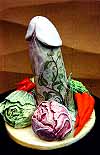 |
Kunc experimented simultaneously with different perspectives. The flatness of a stage
backdrop and an exaggerated foreshortening combine to create a narrow, steeply exposed
space that closes itself off as if it were the side view of an optical illusion. In the
painting "Der Wald" ("The Forest") from 1983, such reverse effects are carried out to their
extreme. The modern "Diana" (1980) penetrates a crookedly unbalanced space in which she,
stiffened into an immovable wooden figure, is in danger of tipping over. There, one
could observe the use of formal and substantive Patterns. A design of curves and points
moves repetitively and jerkily over the canvas, while the situation is constructed with
standard motifs: a large naked woman, a small man in a suit, a rabbit, baby carriage, home
and car. Distortion is added to the often-used technique of reducing perception to
banalities and cliches, and the scenes are often staged in the shadow of an oncoming
disaster. |